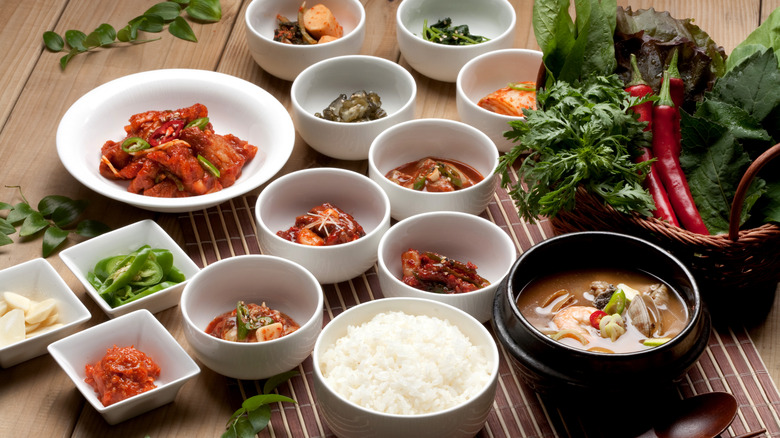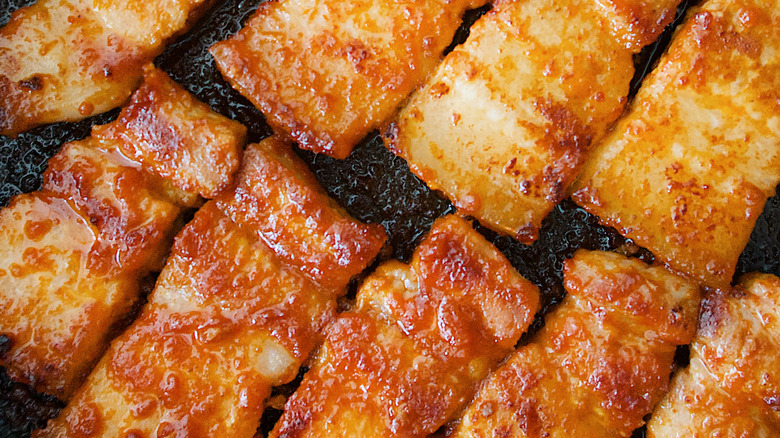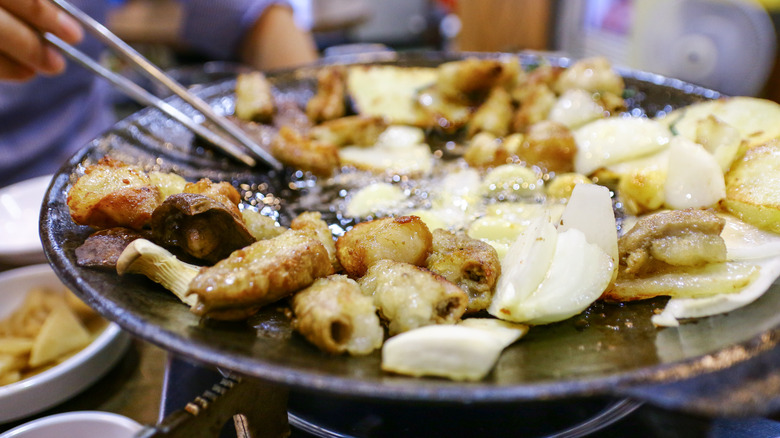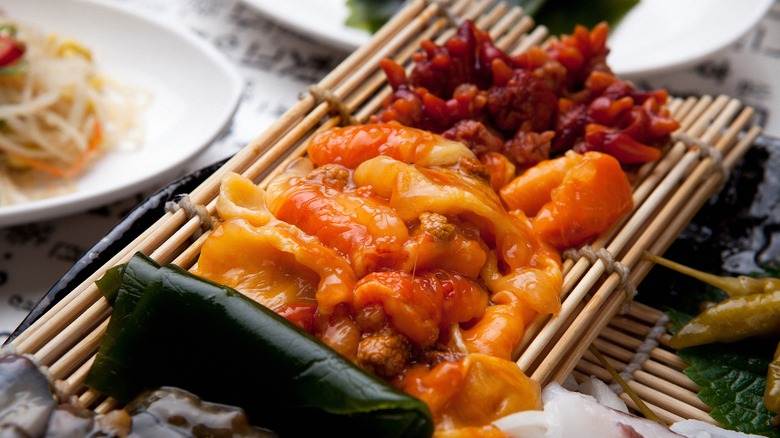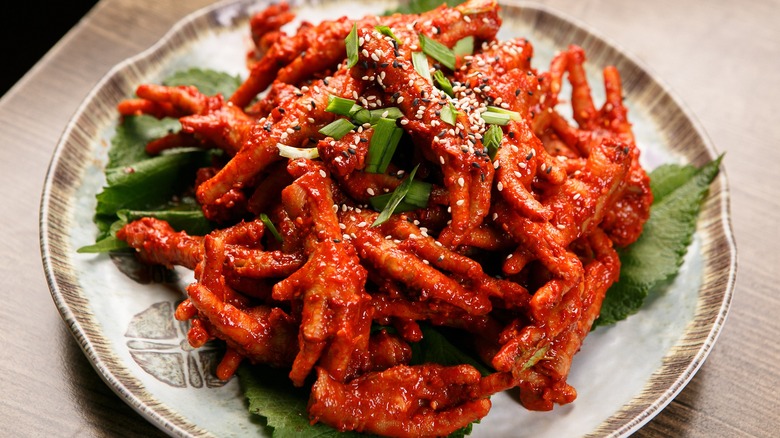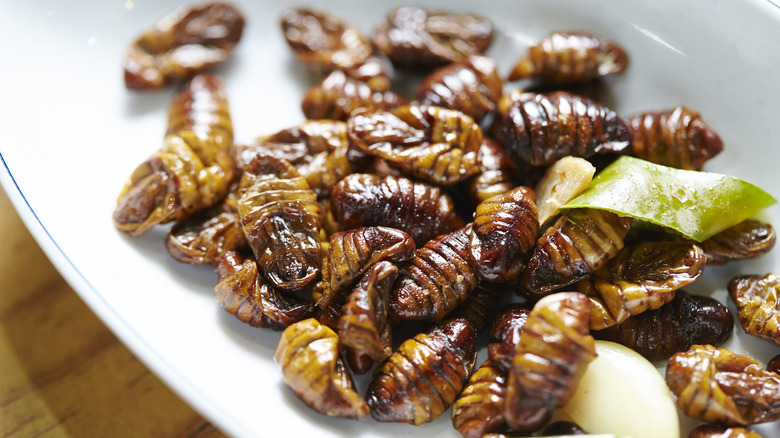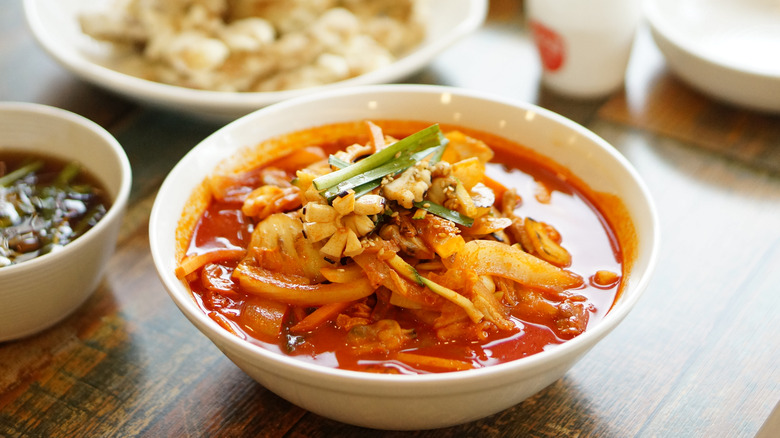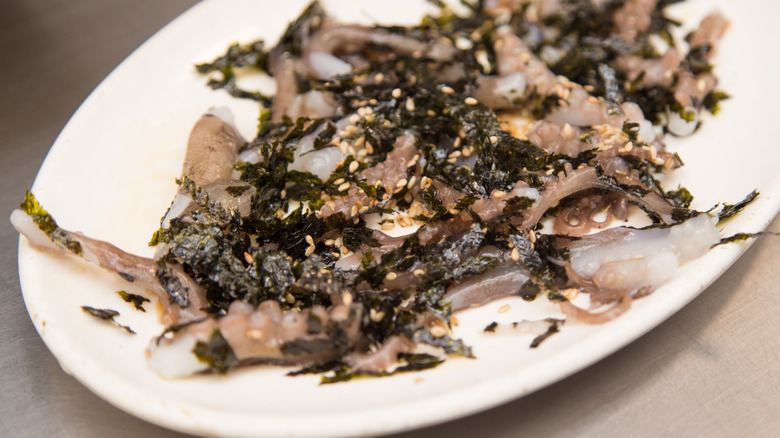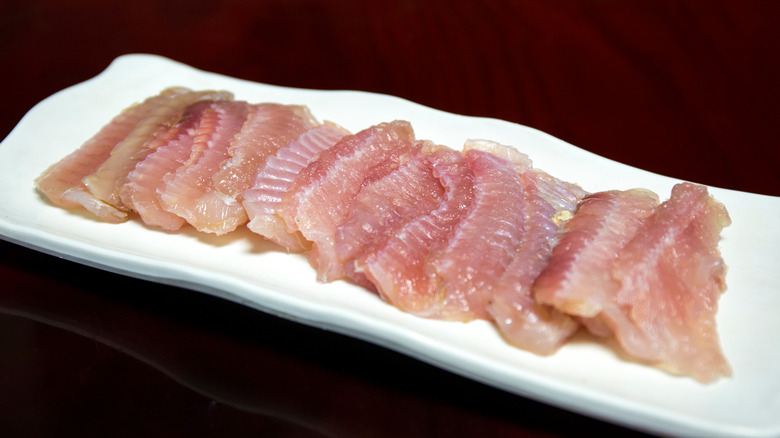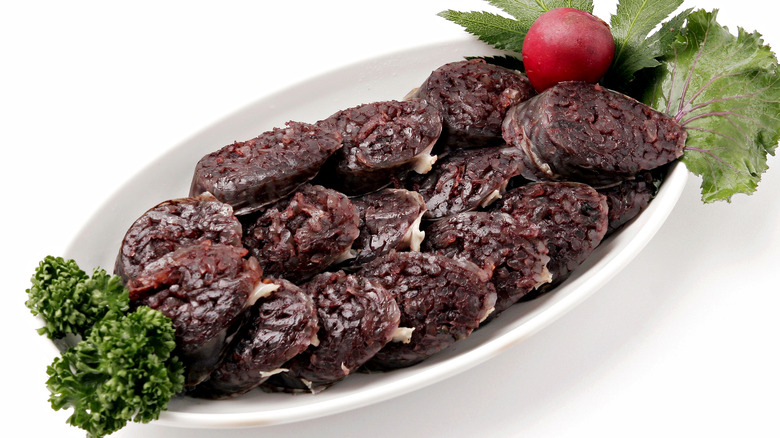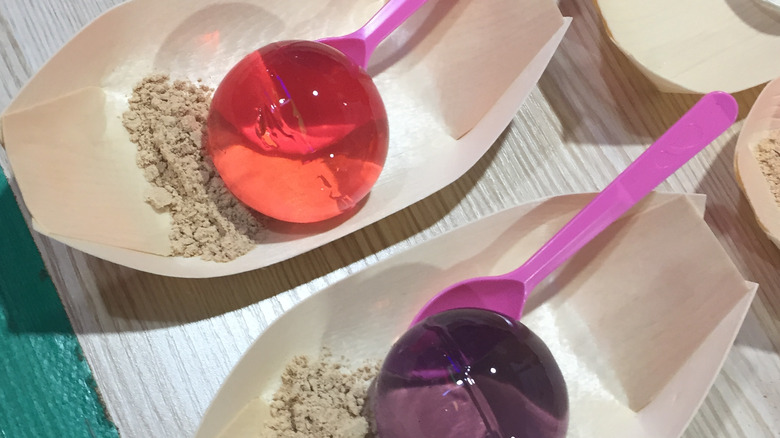Things You Should Never Order From A Korean Restaurant
Interest in all things Korean has exploded around the globe over the past few years. Whether it's bands like Blackpink topping international pop charts, or films like "Parasite," which wowed Oscar voters in 2020, passion for Korean culture outside of Korea itself has never been more prevalent. That love of all things Korean is expanding to our palettes as well.
"Increasing interest in entertainment content, such as movies, television shows and music, has paved the way for more curiosity about the culture, which then opens the door for cuisine," equity analyst Kelly Kim told Morgan Stanley. The financial services company estimates that the sale of prepared Korean snacks such as noodles and chips could more than double in the next two years, topping $10 billion in revenue.
Korean restaurants are also experiencing explosive growth as a result. It's clear that Korean everything is having a moment. But, if you're one of those diners who are eager to explore Korean food culture, be careful. Korean tastes can sometimes differ markedly from what's preferred by American palates. From foods that are ultra-spicy, very salty, or just very out of the box, newbie diners need to be extra thoughtful about Korean food when ordering their next meal. For some, there are a few dishes you should never order at Korean restaurants.
Korean restaurant diners might want to avoid high-fat samgyupsal
From college students to office workers, many Koreans love samgyupsal. The dish, which features large strips of grilled pork belly, is sometimes marinated with garlic, herbs, and wine, and is typically prepared directly on a customer's table in a restaurant. Diners flip the meat themselves and eat the crispy meat directly from the grill. The problem with samgyupsal is that it's so incredibly fatty. "The slices usually gush with oil that slithers down into a grease cup that the restaurant generously offers," says Constance Williams at Korea Biomedical Review.
Berkeley Wellness agrees with that assessment, calling samgyupsal one of the most unhealthy Korean dishes out there, while Livestrong has estimated that "each ounce of pork belly contains 145 calories." With a recommended serving size of 3 ounces, dishes like samgyupsal can contain upwards of 500 calories. That's nearly three times the amount found in a comparably sized serving of a lean protein source such as chicken.
The calories and fat in samgyupsal won't just impact your weight. They could also kill you. The Journal of Animal Science and Technology studied pork belly consumption habits in South Korea and found that the more people ate dishes like samgyupsal, the more likely they were to suffer serious long-term health problems like high cholesterol, atherosclerosis, and cardiovascular disease.
Gopchang is a bad choice for Korean restaurant diners with sensitive stomachs
If the uber chewy texture and tough, rubbery consistency of gopchang don't scare you away, the fact that it's actually large chunks of pork intestine might do the trick. According to travel site (a)broad, "this dish gained popularity because while packed with nutrients, it's [also] dirt cheap to make."
Taste Atlas reports that gopchang is widely popular across South Korea today and is thought of much like burgers and wings are here in the United States. For many, it's a perfect late-night food to chow down upon after a late-night pub crawl. That's because the dish is also considered the perfect food to enjoy with the Korean spirit and national beverage known as soju.
For those who love the dish, the blend of its flavor plus an elastic chew is said to be unlike almost anything else one can eat in South Korea or beyond (via Taste). However, few think gopchang will ever catch on in the U.S. "I don't think intestines will ever be all that popular," food critic Matthew Kangtold explained to Taste. "Even if all of BTS promotes it." To be fair, tripe, which is also made from animal intestines, is a popular ingredient worldwide, including its use as chitterlings in the United States. Yet picky and sensitive eaters may want to decide ahead of time if they're ready to chow down on intestines before ordering gopchang at a Korean restaurant.
Gaebul is a seafood dish with an explicit ingredient
If eating the intestines in gopchang seems like too great a challenge for your taste buds, then you'll likely want nothing to do with a plate of gaebul, sometime called "spoon worm" and also more colorfully known as "penis fish." Now, before you avert your eyes, please know that there's no male anatomy (fish or otherwise) actually involved here. Rather, as Sunny Side Circus reports, these worms are actually a fairly common type of sea critter that burrows into the sand and mud found along ocean beaches. While it's incredibly chewy, gaebul is relatively free of flavor until you mash it between your teeth and find a clam-like flavor.
Gaebul is usually served sashimi-style, cut into thin strips which are subsequently eaten raw. Since the spoon worm is kept alive until just before it is served, the strips may also still be wriggling when diners pick them up in their chopsticks (via HuffPost). For those who are squeamish about moving food, gaebul can also be grilled on a skewer.
Although the dish can be hard to find on American menus, spoon worms themselves are incredibly common even in North America. According to Bay Nature, a 2019 storm caused thousands of worms to wash up on a beach in California. For many witnesses, the wriggling mass it very clear why the creatures got their somewhat less-than-appropriate for primetime name.
Dining on dakbal can be a spicy challenge in a Korean restaurant
As Smithsonian Magazine reports, Korean fried chicken is a highly popular dish in the Korean peninsula and beyond. The namesake poultry is dipped in a thin cornstarch coating, fried, and then coated with soy, garlic, and other sweet and spicy sauces. For many diners, it's incredibly tasty and even downright addictive. But as popular as Korean fried chicken may be, Koreans have been eating another chicken dish way longer. It's called dakbal, and it's basically boiled, stir-fried chicken feet.
The Korea Herald reports that dakbal is a pretty logical product of Korean culture, where cooks have historically had to get creative to utilize every part of an animal. To make the small amount of meat on the feet edible, they're generally grilled or boiled in water and then broiled in a super spicy red sauce containing a variety of peppers plus soy sauce, garlic, vinegar, and sugar (via The Daily Meal).
"As many Koreans prefer tongue-numbing spiciness, chicken feet are often very hot," The Korea Herald reports. "Koreans describe the dish as 'burning the tongue off' and drink sweet beverages or eat seasoned rice balls to tame the heat."
How, exactly, should one consume dakbal if they're feeling up to the challenge? Put the whole chicken foot in your mouth and chew, spitting the tiny bones out as they break free from the leathery skin. To make the process easier, some restaurants will remove the claws before cooking.
Insect-phobes will want to steer clear of beondegi in Korean restaurants
A popular street food all over South Korea, beondegi is none other than the freshly hatched larva of the silkworm. Popularized during the Korean war when sources of protein grew scarce, the insects became an obvious alternative food source for hungry people. The silkworm pupae were already in plentiful supply throughout the country, where they were used to provide the raw material for silk fabric (via Atlas Obscura).
Beondegi sports a fishy and nutty flavor and has an appearance similar to coffee beans while cooking. Beondegi is typically either boiled, grilled, or steamed. It's then seasoned with salt and spices and served in paper cups with a toothpick so diners can skewer the cooked larvae. In some restaurants, they're also served as a side dish.
The worms are so popular in South Korea that they're also sometimes used to make beondegi soup. To prepare it, Taste Atlas reports that the "silkworm pupae is marinated in sweet soy sauce, then boiled for a long time in water." While the dish isn't very common in the United States and harder to find on a menu in U.S.-based Korean restaurants, that doesn't mean you'll never run across it. Canned beondegi is commonly found in many Asian supermarkets.
In a Korean restaurant, jjambbong may set your mouth on fire
While many people love fiery meals full of spice, the American Society for Horticultural Science has revealed that about 21 percent of people surveyed said that they dislike or hate spicy foods. That could be a significant hurdle for anyone dining in a Korean restaurant, where many of the dishes sport searing flavor profiles. Even people who eat spicy food all the time might want to think twice. Milder options are available, especially if you ask the waiter nicely, but there are some dishes that the spice-averse must simply avoid.
For these individuals, jjambbong, a flaming hot seafood noodle dish popular is Korea, is definitely a menu item to stay far, far away from. CNN has called the dish "ridiculously hot" and dubbed it one of the spiciest entree options you can find in a typical Korean restaurant. "One mouthful of noodles is enough to cause acute pain on the tongue," CNN reported. "Add a spoonful of broth and your entire head may feel that it's been set on fire."
Nutritionist Jim White explained to Eat This, Not That that when you eat something like jjambbong that your body recognizes as spicy, that burning fiery sensation is actually all in your head. It's all a trick of receptors on your tongue mistaking chemicals within the food as actual heat, then fooling the brain into thinking that tissue on the tongue is about to be painfully scorched by your meal.
Sannakji is served so fresh, it might fight back
Octopus can be served in many ways, but live and clinging to the chopstick seems pretty questionable, at least for eaters who aren't used to the prospect of their food fighting back.
Sannakji can be prepared in one of two different ways. In one technique, live baby octopus are taken from a tank and chopped into small pieces which are then served directly to a diner's table. In many cases, the pieces of octopus are still wriggling by the time they hit the plate. The meat in this dish has been known to cling to chopsticks and even stick to the diner's teeth while they're being chewed (via Tastes Seoul Good).
Alternately, an entire live octopus can also be brought out as an entree. In this case, the octopus is again dipped in one of the sauces for a bit of extra lubrication. The diner then puts the whole creature into their mouth and chews vigorously until the octopus is dead and can be swallowed. Whether or not you like the idea of sannakji, it's clear that the process can be fairly dangerous if you can't commit to the meal. If you don't chew thoroughly enough, it's possible that the tentacles will cling to the throat when you swallow and lodge there, quickly causing suffocation. Approximately six people are said to choke to death this way every year, according to Food & Wine.
Hongeo has a very potent odor
Hongeo consists of a flatfish called a skate which is generally cleaned and then aged for a month or longer before being served. While that in itself sounds fairly ordinary, skates are unusual fishes. Plainly put, they can't pee. Instead of urinating like other sea creatures, skates excrete their waste through their skin. This means that, when skate are left to age, they actually end up fermenting in their own waste, which includes uric acid. That's the stuff that makes urine smell and makes flatfish meat smell quite the same. The uric acid gradually breaks down throughout the aging process, creating a scent similar to ammonia (via Culture Trip).
According to NPR, the dish "has a sharp, pungent aroma –- one might describe it as a heady mix of public toilet and wet laundry left untended for days." Yet, though Westerners might take a step back when presented with this fermented fish dish, many Koreans report that they love its taste. In Mokpo, a city on the southwestern coast of South Korea, it's even a significant factor in their local economy.
The New York Times wasn't quite as kind as locals may be towards hongeo, calling the stench of the dish similar to that of a ripe outhouse. "Served most often as chewy pink slabs of sashimi, hongeo is prized by enthusiasts for the ammonia fumes it releases, sometimes so strong they cause people's mouths to peel," the paper reported.
For some Korean restaurant-goers, sundae is bloody unappetizing
While the preparation techniques, spices, and ingredients used in various versions of blood sausage can vary widely, all blood sausage has one thing in common — it's made using the actual blood from an animal (via Black Pudding Club).
As a classic British dish, it's frequently called black pudding and looks a bit like chocolate mousse. In Germany, it's called blutwurst and is served dried and sliced, sometimes topped with applesauce. In Korea, blood sausage is called sundae or soondae. It's usually made from pig or cow intestine that's been stuffed with noodles, barley, and occasionally kimchi, all of which "serve to soak up the dark blood" (via Food Republic).
Sundae is, for many, a bit mushy with a mild, mineral-like flavor. Compared to other types of blood sausage, it's also quite a bit lighter than other versions of blood sausage, sporting "a jelly-like texture which breaks up and melts in your mouth when you eat it," according to food blog Easy Korean Food.
Blood sausages like sundae are also considered fairly unhealthy. The Independent has warned that blood sausage can be high in calories, fat, and salt, since it's made from sodium-rich blood. It's also highly processed, which researchers have warned could lead to an increased risk of colon cancer if consumed too frequently. If you're intrigued by sundae and want to try it, just remember to make this dish a sometimes treat.
Some argue that mulbangwul looks better than it tastes
Although it may look stunning in pictures, most people consider mulbangwul a bit of a taste disappointment. Loosely translated as "water cake" or "water rice cake," mulbangwul is basically a very sticky, rather flavorless cross between pudding and Jell-O. Unlike animal-based gelatin, Korean cooks make mulbangwul with strong mineral water plus agar. As per Britannica, agar is a vegan alternative to gelatin that comes from red algae. According to the blog Chopstix Chronicles, the agar is first mixed with water. The resulting mixture is then poured into a mold and allowed to cool for at least an hour. Water drop cakes come in a variety of flavors. Clear mulbangwul are virtually flavorless. Colored mulbangwul "drops" can be savory and flavored with things like soy sauce. Other versions are sweet and come with a variety of fruit flavors such as strawberry, mango, orange, or lime.
Before being served, chefs typically top the dish with a molasses-like syrup plus kinako, a nutty roast soybean flour that's very high in fiber and used for added texture and crunch. With mulbangwul, it seems that diners either love it or hate it. Some find the fruitiness unique and refreshing. Other people tend to consider the dish way too sweet or dislike the gummy, gluey texture, according to Wow Korea, which they argue is way too aggressive for a simple snack or dessert.
